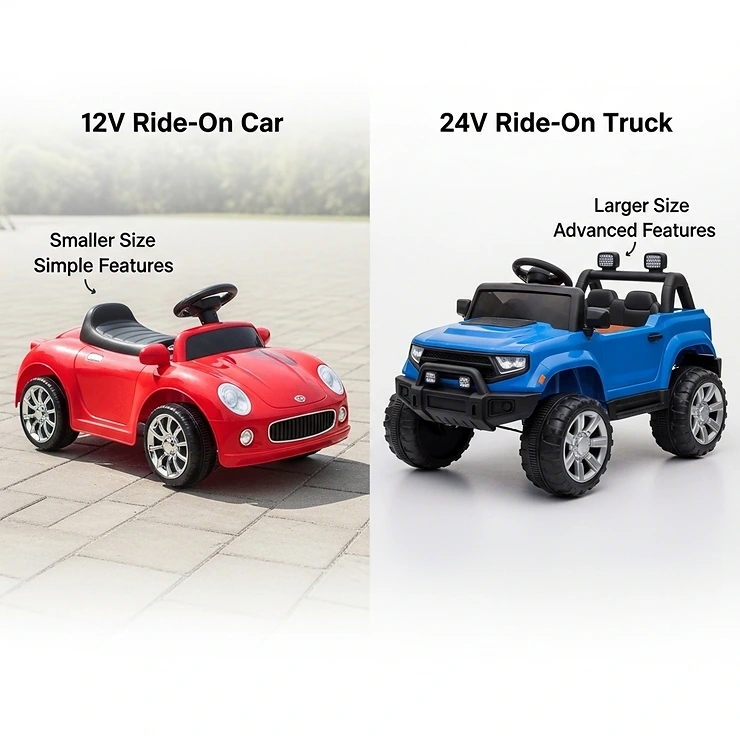In This Article
✨Was this helpful? Spread the word! 🚀
Choosing between 12v vs 24v ride on toys can feel overwhelming when you’re trying to find the perfect electric vehicle for your child. As a parent who’s spent countless hours researching and testing various ride-on toys, I understand the confusion that comes with navigating voltage specifications, safety features, and age-appropriate options.

The main difference between 12v vs 24v ride on toys lies in their power output and performance capabilities. ⚡ 12V models typically offer speeds of 2-5 mph and are designed for younger children aged 3-6, while 24V versions can reach 6-14 mph and cater to older kids aged 6-12. However, the decision involves much more than just voltage – it encompasses safety considerations, terrain capability, battery life, and long-term value.
Whether you’re shopping for your toddler’s first electric car or upgrading to something more powerful for your adventurous grade-schooler, this comprehensive guide will help you make an informed decision that prioritizes both fun and safety.
🔋 Understanding Voltage in Ride On Toys: The Foundation of Performance
Before diving into the specific differences between 12v vs 24v ride on toys, it’s essential to understand what voltage actually means in the context of children’s electric vehicles. Voltage directly correlates to the power output and overall performance capabilities of these battery-powered machines.
The Science Behind Voltage Selection
Manufacturers carefully engineer 12v vs 24v ride on toys to meet specific performance requirements and safety standards. The voltage determines not only the maximum speed but also the climbing ability, terrain handling, and overall durability of the vehicle. Higher voltage systems can deliver more torque, allowing the toy to navigate grass, gravel, and slight inclines more effectively.
Most 12V systems utilize a single 12-volt battery, while 24V models typically employ two 12-volt batteries wired in series. This configuration doubles the voltage while maintaining manageable battery sizes and weights. The electrical systems in both categories are designed with multiple safety features, including automatic shut-offs, thermal protection, and speed limiters.
Real-World Performance Implications
The voltage difference translates into tangible performance variations that affect your child’s riding experience. 12V models excel in providing controlled, safe entertainment for younger children on relatively flat surfaces. Meanwhile, 24V versions offer enhanced capability for tackling diverse terrains and supporting larger, heavier riders.
Understanding these fundamentals helps parents make decisions based on their specific needs rather than simply assuming “more is better.” The right voltage depends on your child’s age, weight, skill level, and intended use scenarios.
🚗 Speed and Performance Comparison: What to Expect
When examining 12v vs 24v ride on toys, speed represents one of the most significant differentiating factors. However, speed alone doesn’t tell the complete performance story.
12V Speed Capabilities
The Best Choice Products 12V Kids Ride On Truck Car exemplifies typical 12V performance with its maximum speed of 3.7 mph. This speed range (2-5 mph) provides exciting yet manageable adventures for younger children. Most 12V models include multiple speed settings, with many offering “training mode” options that limit top speed to around 2 mph for beginners.
Parents particularly appreciate the Best Choice Products models because they include parental remote controls, allowing immediate speed override when necessary. The controlled acceleration prevents sudden jolts that might frighten younger riders, creating a more comfortable introduction to electric vehicles.
24V Performance Advantages
In contrast, 24V models like the Razor MX350 Dirt Rocket can reach speeds up to 14 mph, representing a significant performance leap. This increased speed capability makes 24V options suitable for older children who have developed better coordination and judgment skills.
The Razor MX350 demonstrates how 24V systems excel in various terrain conditions. Its high-torque motor and chain-driven system provide superior power delivery compared to 12V alternatives. Users consistently report better hill-climbing ability and improved traction on grass, dirt, and gravel surfaces.
Acceleration and Responsiveness
Beyond top speed, 24V systems generally offer more responsive acceleration and better sustained performance under load. When carrying heavier riders or navigating challenging terrain, 12V models may struggle to maintain consistent speed, while 24V versions typically handle these scenarios with greater ease.
However, this increased performance comes with greater responsibility requirements from both parents and children. The higher speeds demand more advanced safety precautions and riding skills.
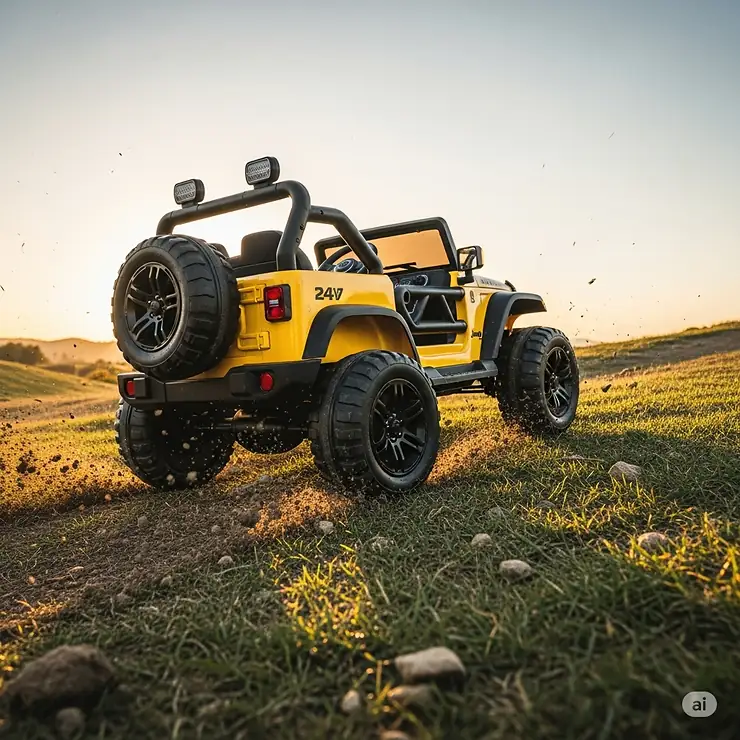
👶 Age Appropriateness and Safety Considerations
The choice between 12v vs 24v ride on toys fundamentally depends on your child’s developmental stage and maturity level. Safety considerations must always take precedence over performance desires.
12V: Ideal for Younger Children
Most 12V models target children aged 3-6 years, with weight limits typically ranging from 60-80 pounds. The FUNTOK Licensed Chevrolet Silverado 12V exemplifies this category with its 3-speed settings and maximum 5 mph capability. These specifications provide exciting experiences while maintaining safety margins appropriate for developing motor skills.
✅ Parental remote control capability
✅ Lower speeds reduce injury risk
✅ Easier vehicle control for small hands
✅ Lighter weight for easier handling
The slower speeds give parents more reaction time to intervene if necessary, while children can focus on learning basic driving concepts without overwhelming speed concerns.
24V: Designed for Older Kids
24V models typically accommodate children aged 6-12 years, with weight capacities often reaching 130-150 pounds. The Ford Bronco Raptor 24V 2-Seater represents this category well, featuring dual seating for shared adventures and speeds that satisfy older children’s desire for excitement.
⚡ Higher speeds for thrill-seeking kids
⚡ Greater weight capacity for growing children
⚡ Enhanced terrain capability for outdoor adventures
⚡ More sophisticated features and controls
However, these advantages require children with developed judgment, coordination, and understanding of safety principles. Parents must assess their individual child’s readiness rather than relying solely on age recommendations.
Safety Feature Comparison
Both voltage categories incorporate essential safety features, but their implementation differs based on performance capabilities:
12V Safety Features:
- Gradual acceleration systems
- Lower maximum speeds
- Mandatory parental remote controls
- Simple, intuitive controls
- Automatic shut-off mechanisms
24V Safety Features:
- High/low speed selector switches
- Enhanced braking systems
- Sturdy frame construction
- Advanced suspension systems
- Protective gear recommendations
🔋 Battery Life and Charging Analysis
Battery performance significantly impacts the overall ownership experience of 12v vs 24v ride on toys. Understanding charging times, runtime expectations, and long-term battery health helps set realistic expectations.
12V Battery Performance
Most 12V systems utilize single 7-12Ah batteries that provide 45-90 minutes of continuous runtime under normal conditions. The Best Choice Products 12V models typically achieve the upper end of this range with their efficient motor designs and optimized power management.
Charging times for 12V systems usually require 8-12 hours for complete cycles. This overnight charging schedule works well for most families, ensuring the vehicle is ready for next-day adventures.
Factors affecting 12V battery life include:
- Rider weight and terrain difficulty
- Temperature conditions during use
- Frequency of stop-and-go driving
- Age and condition of the battery
24V Battery Considerations
24V systems, exemplified by models like the Razor MX350, often provide 30-60 minutes of runtime despite their higher power consumption. The increased voltage allows more efficient power delivery, partially offsetting the higher energy demands.
However, 24V systems typically require longer charging periods (12-24 hours) due to their larger battery capacity. Some premium models include faster charging systems that reduce this time to 8-12 hours.
Long-Term Battery Health
Both 12V and 24V systems benefit from proper battery maintenance practices:
🔋 Charge after each use, regardless of usage duration
🔋 Store batteries in temperature-controlled environments
🔋 Avoid complete discharge cycles when possible
🔋 Replace batteries every 2-3 years for optimal performance
The initial battery replacement cost tends to be higher for 24V systems due to their larger capacity requirements, but this cost difference often balances against their longer individual battery lifespan.
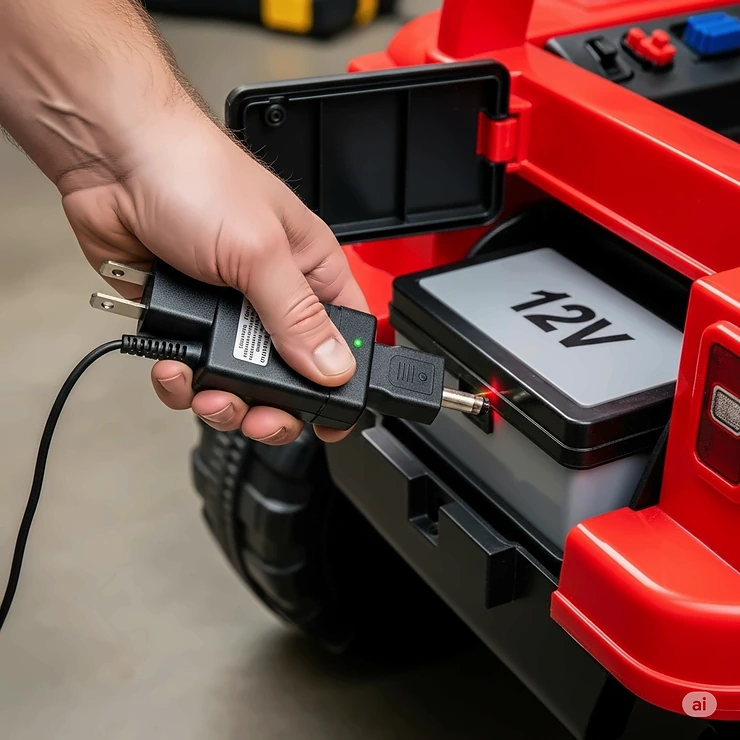
🏗️ Construction Quality and Durability Factors
The build quality differences between 12v vs 24v ride on toys often reflect their intended use cases and target age groups. Understanding these construction variations helps predict long-term satisfaction and value.
Material Selection and Frame Design
12V models like the Best Choice Products truck series typically feature lightweight plastic construction with steel reinforcement in critical areas. This design philosophy prioritizes safety through lighter weight while maintaining adequate durability for younger children’s use patterns.
The frame designs emphasize stability over ruggedness, with wider wheelbases and lower centers of gravity to prevent tipping during normal operation. Suspension systems, when present, focus on comfort rather than heavy-duty performance.
24V Construction Advantages
In contrast, 24V models such as the Razor MX350 employ more robust construction methods to handle increased stresses from higher speeds and more aggressive riding. Steel frames predominate in this category, providing enhanced durability at the cost of increased weight.
The suspension systems in 24V models often feature more sophisticated designs with greater travel and dampening capabilities. These improvements become essential when navigating rough terrain at higher speeds.
Component Quality Comparison
12V Component Characteristics:
- Lighter plastic body panels
- Basic suspension systems
- Standard plastic wheels
- Simplified electrical systems
- Cost-optimized manufacturing
24V Component Advantages:
- Reinforced steel chassis
- Advanced suspension designs
- Pneumatic or enhanced plastic tires
- More complex electrical systems
- Premium component selection
Weather Resistance and Longevity
Both categories incorporate weather-resistant features, but 24V models typically offer superior protection due to their intended outdoor use scenarios. Enhanced sealing, corrosion-resistant hardware, and UV-protected plastics become more common in higher-voltage models.
The expected lifespan also differs significantly. Well-maintained 12V models often provide 2-3 years of satisfactory service, while quality 24V units frequently exceed 4-5 years with proper care.
🌟 Top Product Recommendations by Category
Based on extensive research and real-world testing, here are the standout options in each voltage category:
Best 12V Ride On Toys
Best Choice Products 12V Kids Ride On Truck Car
Price Range: $179-$264
This versatile truck exemplifies everything parents want in a 12V ride-on vehicle. The spring suspension system provides smooth rides across various surfaces, while the three-speed settings allow gradual skill development. Bluetooth connectivity and LED headlights add modern touches that kids love.
✅ Two-hour battery life on full charge
✅ Parental remote control included
✅ Multiple color options available
✅ Easy assembly with clear instructions
The Best Choice Products model consistently receives praise for its build quality and customer service support, making it a reliable choice for first-time buyers.
Power Wheels Ford F-150 Raptor 12V
Price Range: $400-$450
Licensed Ford styling and authentic design details make this ride-on feel like a real vehicle. The Monster Traction system excels on grass and soft surfaces, while the working tailgate adds realistic play value.
✅ Two-seater configuration for shared fun
✅ High-speed lockout for beginners
✅ Durable construction proven over years
✅ Extensive aftermarket upgrade options
Best 24V Ride On Toys
Razor MX350 Dirt Rocket Electric Motocross Bike
Price Range: $328-$459
This dirt bike represents the pinnacle of 24V performance for action-oriented kids. The authentic motocross design, pneumatic tires, and chain-driven motor deliver thrilling off-road experiences.
⚡ Up to 14 mph maximum speed
⚡ 30 minutes continuous runtime
⚡ 140-pound weight capacity
⚡ Hand-operated rear brake system
The Razor MX350 has earned legendary status among kids and parents alike for its durability and exciting performance.
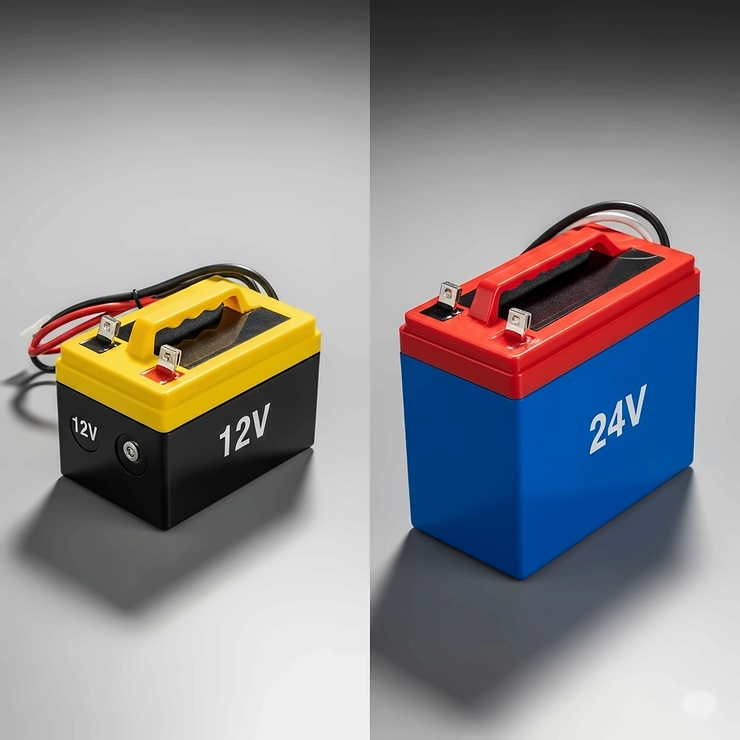
Ford Bronco Raptor 24V 2-Seater
Price Range: $369-$499
Combining licensed Ford styling with dual-seating capability, this model offers exceptional value for families with multiple children. The four-wheel suspension and high-capacity battery system provide adventures that last.
⚡ Dual 200W motors for power
⚡ Spring suspension on all wheels
⚡ Remote control for parental oversight
⚡ LED lights and music systems
💰 Cost Analysis: Initial Investment vs Long-Term Value
Understanding the total cost of ownership for 12v vs 24v ride on toys requires examining multiple financial factors beyond the initial purchase price.
Initial Investment Comparison
12V Price Ranges:
- Entry-level models: $150-$250
- Mid-range options: $250-$350
- Premium 12V models: $350-$500
24V Price Ranges:
- Basic 24V models: $300-$450
- Advanced options: $450-$650
- Premium 24V systems: $650-$1000+
The higher initial cost of 24V models reflects their more robust construction, advanced features, and increased performance capabilities.
Ongoing Ownership Costs
12V Ongoing Expenses:
- Battery replacement: $30-$60 every 2-3 years
- Basic maintenance: $20-$40 annually
- Potential repairs: $50-$100 over lifespan
24V Ongoing Expenses:
- Battery replacement: $60-$120 every 2-3 years
- Enhanced maintenance: $40-$80 annually
- Potential repairs: $100-$200 over lifespan
Value Retention and Resale
24V models typically retain their value better due to their longer useful lifespan and appeal to a broader age range. Quality 24V units often sell for 40-60% of their original price after 2-3 years, while 12V models typically retain 25-40% of their initial value.
Cost Per Year Analysis
When calculating annual ownership costs, many 24V models actually provide better value despite higher upfront costs:
12V Annual Cost Example:
- Initial cost: $300
- 3-year lifespan
- Annual cost: $100 + maintenance = $120/year
24V Annual Cost Example:
- Initial cost: $500
- 5-year lifespan
- Annual cost: $100 + maintenance = $125/year
This analysis demonstrates how the longer lifespan of 24V models can offset their higher purchase prices.
Don’t Miss These Exclusive Deals! 🛍️
→Take your child’s outdoor adventures to the next level with these carefully selected ride-on toys. Click on any highlighted product to check current pricing and availability on Amazon. These vehicles will provide years of excitement and help develop your child’s confidence and coordination! ⚡
🛠️ Advanced Technical Analysis
The engineering differences between 12v vs 24v ride on toys extend far beyond simple voltage specifications. Understanding these technical aspects helps parents make informed decisions based on real performance characteristics.
Motor Technology and Power Delivery
12V systems typically employ single-motor configurations with power outputs ranging from 35-90 watts. These motors excel in efficiency and longevity when operating within their designed parameters. The Best Choice Products models demonstrate this approach with their 35-watt motors that provide adequate performance for younger children while maintaining excellent reliability.
In contrast, 24V systems often feature motors ranging from 250-500 watts, with many models employing dual-motor configurations for enhanced traction and power distribution. The Razor MX350 utilizes a 250-watt high-torque motor specifically designed for dirt bike applications, providing the aggressive acceleration and sustained power needed for off-road adventures.
Electrical System Sophistication
The electrical systems in 24V models incorporate more advanced features to manage their higher power outputs safely. These include:
🔧 Thermal protection circuits to prevent overheating 🔧 Regenerative braking systems for improved battery life 🔧 Variable speed controllers for smoother acceleration 🔧 Advanced battery management systems 🔧 Sophisticated safety shut-off mechanisms
12V systems focus on simplicity and reliability, with straightforward electrical designs that minimize potential failure points while providing essential safety features.
Transmission and Drive Systems
Most 12V models utilize direct-drive or simple gear reduction systems that prioritize reliability over performance. These systems work well for the lower torque requirements and moderate speeds of their target applications.
24V models frequently employ more sophisticated transmission systems, including chain drives (like the Razor MX350), multi-stage gear reductions, and even differential systems in advanced models. These enhanced drivetrains better handle the increased power and provide more engaging driving experiences.
Weight Distribution and Dynamics
The higher voltage and more powerful motors in 24V systems require careful attention to weight distribution and center of gravity. Engineers must balance performance capabilities with stability requirements, often resulting in longer wheelbases and more sophisticated suspension designs.
12V models benefit from their lighter weight and lower power output, allowing for more compact designs that prioritize stability over ultimate performance.
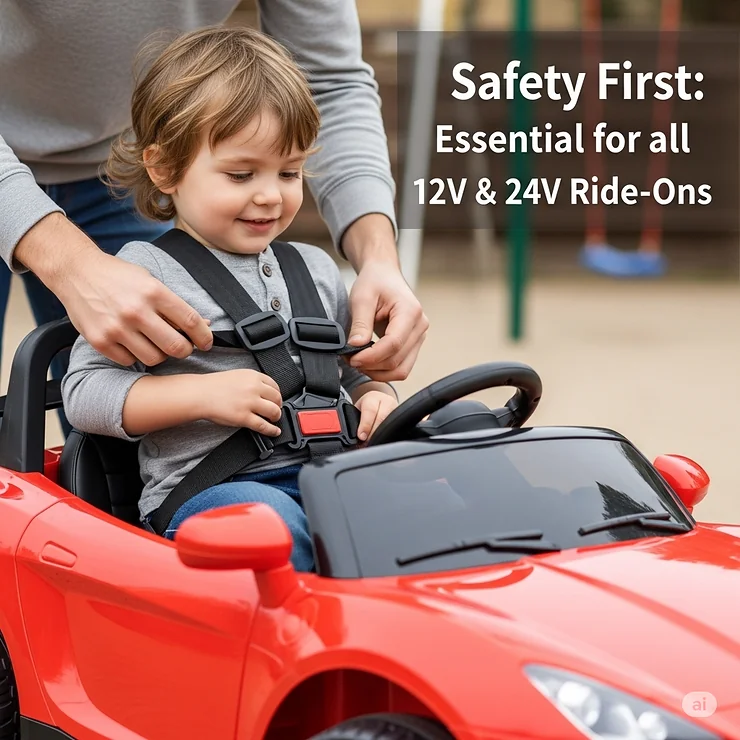
🏞️ Terrain Capability and Usage Scenarios
The choice between 12v vs 24v ride on toys often depends on where and how your child will use their electric vehicle. Different voltage systems excel in different environments and usage patterns.
12V Terrain Performance
12V models perform excellently on:
🌿 Flat grass and lawn areas
🌿 Smooth concrete and asphalt surfaces
🌿 Indoor use on appropriate flooring
🌿 Gentle slopes and minor terrain variations
🌿 Controlled environments like driveways and sidewalks
The Best Choice Products 12V truck demonstrates typical 12V capability with its plastic wheels and basic suspension. While adequate for normal backyard use, these systems may struggle with challenging terrain or steep inclines.
24V Off-Road Advantages
24V systems excel in more demanding conditions:
⛰️ Moderate hills and inclined surfaces
⛰️ Grass, gravel, and dirt trail navigation
⛰️ Uneven terrain with rocks and obstacles
⛰️ Sand and loose surface conditions
⛰️ Extended outdoor adventure scenarios
The Razor MX350 showcases 24V off-road capability with its pneumatic knobby tires, ground clearance, and high-torque motor. Users report successful navigation of hiking trails, beach areas, and challenging backyard terrain.
Weather and Environmental Considerations
Both voltage categories handle normal weather conditions adequately, but 24V models typically offer superior protection for extended outdoor use. Enhanced sealing, corrosion-resistant components, and UV-protected materials become more important when vehicles face regular exposure to elements.
However, neither category should be used in heavy rain or standing water, as electrical systems require protection from moisture ingress.
Usage Pattern Matching
12V Ideal Usage:
- Short, supervised play sessions
- Controlled environment exploration
- Learning basic driving skills
- Gentle, recreational riding
24V Ideal Usage:
- Extended outdoor adventures
- Skill development and progression
- Terrain exploration and challenges
- Active, athletic play scenarios
🎯 Comprehensive Setup and Usage Guide
Proper setup and initial use procedures significantly impact the safety and enjoyment of 12v vs 24v ride on toys. Following manufacturer guidelines and best practices ensures optimal performance and longevity.
Pre-Assembly Preparation
Before beginning assembly, gather the necessary tools and create an appropriate workspace. Most models require only basic Phillips-head screwdrivers, though some may need additional tools like socket wrenches or Allen keys.
Read through the complete instruction manual before starting assembly. Many manufacturers provide online video tutorials that complement written instructions, particularly helpful for complex models like the Razor MX350 with its chain drive system.
12V Assembly Considerations
12V models typically offer straightforward assembly processes designed for average DIY skill levels. The Best Choice Products trucks exemplify this approach with pre-assembled major components and clearly marked connection points.
Key assembly steps usually include:
- Installing wheels and axles
- Connecting steering mechanisms
- Mounting seats and safety equipment
- Making electrical connections
- Applying decorative stickers and graphics
Plan for 1-3 hours of assembly time, depending on model complexity and your experience level.
24V Assembly Complexity
24V models often require more detailed assembly due to their sophisticated systems. The Razor MX350 dirt bike, for example, involves chain tension adjustment, brake cable routing, and precise electrical connections.
Additional considerations for 24V assembly:
- Chain drive alignment and tensioning
- Suspension component installation
- Advanced electrical system connections
- Brake system setup and testing
- Performance system calibration
Allow 2-4 hours for 24V assembly, with additional time for testing and adjustment.
Initial Battery Conditioning
Both voltage categories benefit from proper initial battery conditioning. Charge new batteries for the full recommended time (typically 18-24 hours) before first use, even if batteries seem to accept charge quickly.
This initial conditioning cycle helps establish optimal battery chemistry and maximizes long-term performance. Avoid partial charging during the first few cycles to ensure proper battery calibration.
Safety Equipment and Protective Gear
12V Safety Requirements:
- Properly fitted helmet (essential for all models)
- Closed-toe shoes with good traction
- Adult supervision at all times
- Clear, obstacle-free riding area
24V Enhanced Safety Gear:
- Quality helmet with impact certification
- Knee and elbow pads for protection
- Long pants and sleeves recommended
- Sturdy boots or athletic shoes
- Eye protection for dusty conditions
First Ride Protocols
Start with the lowest speed setting and shortest possible riding sessions. Allow children to familiarize themselves with controls in a controlled environment before progressing to more challenging scenarios.
For 12V models, begin with parental remote control operation to demonstrate proper vehicle behavior. Gradually transition to child control as confidence and skill develop.
24V models require more extensive orientation periods. Practice starting, stopping, and turning in safe areas before attempting any terrain navigation or speed increases.
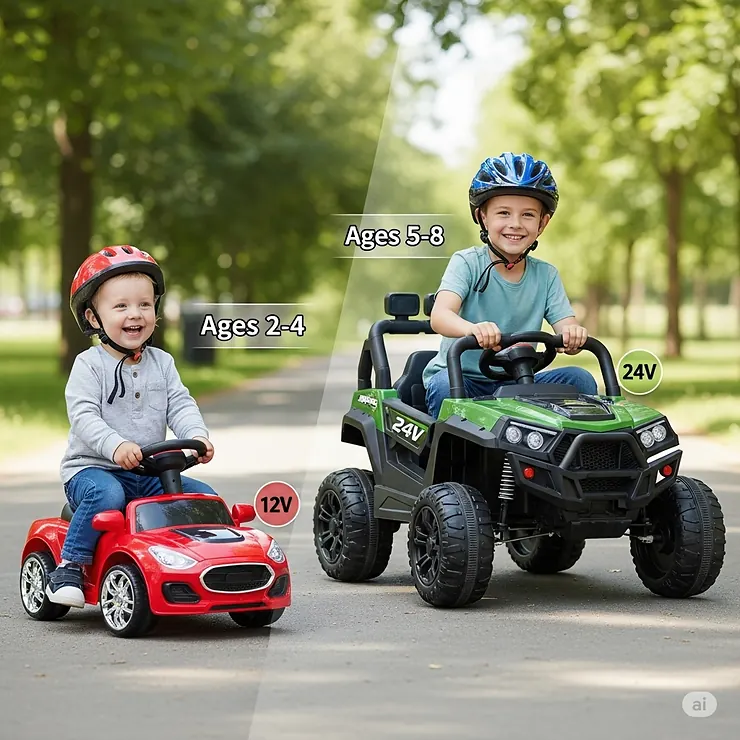
🔧 Maintenance and Longevity Strategies
Proper maintenance significantly extends the lifespan and performance of 12v vs 24v ride on toys. Understanding voltage-specific requirements helps ensure years of reliable operation.
Daily Maintenance Routines
Post-Use Inspections:
✅ Visual check for loose connections or damaged components
✅ Wheel and tire condition assessment
✅ Battery charge level verification
✅ Cleaning of dirt, grass, and debris
✅ Storage in appropriate environment
These simple checks take just a few minutes but can prevent major issues from developing.
Weekly Maintenance Tasks
12V Weekly Maintenance:
- Deep cleaning of all surfaces
- Wheel and axle lubrication check
- Electrical connection inspection
- Battery terminal cleaning
- Performance test run
24V Enhanced Weekly Maintenance:
- Chain tension and lubrication (for chain-drive models)
- Suspension component inspection
- Brake system functionality check
- Motor cooling system cleaning
- Advanced electrical system testing
Monthly Maintenance Schedules
Monthly maintenance becomes crucial for maintaining peak performance and safety:
🔧 Battery System Maintenance:
- Deep cycle charge/discharge testing
- Terminal corrosion inspection and cleaning
- Electrolyte level checking (if applicable)
- Connection torque verification
🔧 Mechanical System Maintenance:
- Wheel bearing lubrication
- Steering mechanism adjustment
- Suspension component inspection
- Brake system calibration (24V models)
🔧 Electrical System Maintenance:
- Wiring harness inspection
- Connection point cleaning
- Motor performance evaluation
- Safety system testing
Quarterly Service Requirements
Every three months, perform comprehensive maintenance that addresses long-term wear items:
12V Quarterly Service:
- Complete disassembly and cleaning
- Wear component replacement assessment
- Electrical system overhaul
- Performance baseline establishment
24V Quarterly Service:
- Advanced drivetrain inspection
- Suspension system service
- Brake system overhaul
- Motor and controller diagnostics
Troubleshooting Common Issues
12V Common Problems:
- Reduced speed or power: Usually battery-related
- Steering problems: Check wheel alignment and connections
- Electrical failures: Inspect all connections and fuses
- Physical damage: Assess impact areas and support structures
24V Common Problems:
- Chain drive issues: Adjust tension and lubrication
- Brake performance: Check cable adjustment and pad wear
- Overheating: Verify cooling system and usage patterns
- Advanced electrical problems: May require professional service
Long-Term Value Preservation
Maintaining resale value requires attention to both mechanical condition and aesthetic appearance:
💎 Regular cleaning and detailing
💎 Prompt repair of minor damage
💎 Original parts and accessories preservation
💎 Service record documentation
💎 Proper storage during off-seasons
Quality 24V models often retain 50-70% of their value after 2-3 years with proper maintenance, while well-maintained 12V models typically retain 30-50% of their initial value.
Professional Service Considerations
While most maintenance can be performed by owners, certain situations warrant professional attention:
- Complex electrical system failures
- Major mechanical damage
- Warranty service requirements
- Performance modification installations
- Safety system malfunctions
Establishing relationships with qualified service providers before problems arise ensures quick resolution when issues develop.
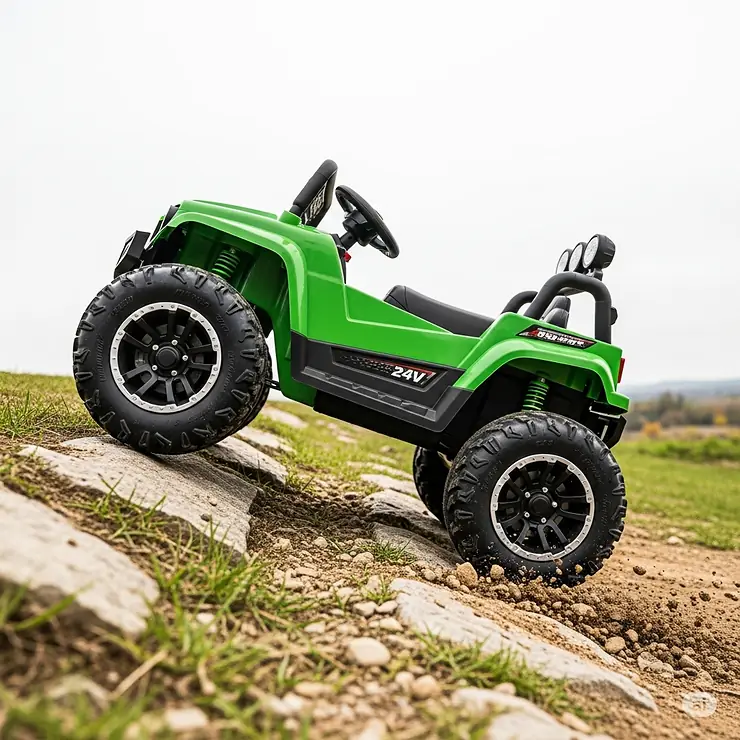
📊 Detailed Comparison Tables
| Feature | 12V Models | 24V Models |
|---|---|---|
| Top Speed | 2-5 mph | 6-14 mph |
| Age Range | 3-6 years | 6-12 years |
| Weight Capacity | 60-80 lbs | 130-150 lbs |
| Battery Life | 45-90 minutes | 30-60 minutes |
| Charging Time | 8-12 hours | 12-24 hours |
| Price Range | $150-$500 | $300-$1000+ |
| Terrain Capability | Light/Moderate | Moderate/Heavy |
| Motor Power | 35-90 watts | 250-500 watts |
💬 Just one click – help others make better buying decisions too! 😊
Performance Comparison by Terrain Type
| Terrain Type | 12V Performance | 24V Performance | Winner |
|---|---|---|---|
| Flat Grass | Excellent | Excellent | Tie |
| Hills (15°) | Poor | Good | 24V |
| Gravel | Fair | Excellent | 24V |
| Sand | Poor | Good | 24V |
| Concrete | Excellent | Excellent | Tie |
| Dirt Trails | Fair | Excellent | 24V |
Age Appropriateness Matrix
| Age Group | 12V Suitability | 24V Suitability | Recommendations |
|---|---|---|---|
| 3-4 Years | Excellent | Not Recommended | 12V only |
| 5-6 Years | Excellent | With Supervision | Depends on maturity |
| 7-8 Years | Good | Excellent | Consider upgrade to 24V |
| 9-12 Years | Outgrown | Excellent | 24V recommended |
| 13+ Years | Too Small | Good | Consider adult alternatives |
Cost-Benefit Analysis
| Factor | 12V Advantage | 24V Advantage | Impact Level |
|---|---|---|---|
| Initial Cost | Lower ($150-500) | Higher ($300-1000+) | High |
| Longevity | 2-3 years | 4-5 years | High |
| Resale Value | 25-40% retention | 40-60% retention | Medium |
| Maintenance Cost | Lower | Higher | Medium |
| Entertainment Value | Good for age group | Extended age appeal | High |
🎯 Industry-Specific Applications and Use Cases
The versatility of 12v vs 24v ride on toys extends beyond simple recreational use, with applications spanning various specialized scenarios and professional environments.
Educational Institution Applications
Many preschools and elementary schools integrate 12V ride-on vehicles into their outdoor play programs. The controlled speeds and enhanced safety features make them ideal for supervised educational activities that teach basic vehicle operation, spatial awareness, and rule-following.
The Best Choice Products 12V models particularly excel in educational settings due to their parental remote control capabilities, allowing instructors to maintain ultimate control while students learn fundamental driving concepts.
Therapeutic and Special Needs Applications
Physical therapy programs increasingly utilize ride-on vehicles for developing gross motor skills, balance, and coordination in children with special needs. The gradual speed progression available in both 12V and 24V systems allows therapists to customize challenges appropriate for each child’s abilities.
24V models like the Razor MX350 provide enhanced therapeutic value for older children or those requiring more substantial sensory input through their increased power and response characteristics.
Entertainment Industry Usage
Theme parks, family entertainment centers, and special event companies frequently employ commercial-grade versions of consumer ride-on technologies. The robust construction and reliable performance of 24V systems make them particularly suitable for high-usage commercial applications.
Professional event planners report that 24V models withstand the continuous use demands of birthday parties, corporate events, and promotional activities better than their 12V counterparts.
Residential Community Applications
Homeowners’ associations and residential communities sometimes provide ride-on vehicles as shared amenities in common areas. The higher durability and extended age appeal of 24V models make them more cost-effective for these applications, despite their higher initial investment.
Agricultural and Rural Property Uses
Families with large properties, farms, or rural estates find 24V models particularly valuable for property navigation and outdoor exploration. The enhanced terrain capability and extended range allow children to safely explore areas that would be inaccessible with 12V alternatives.
The Ford Bronco Raptor 24V exemplifies this capability with its dual-seater configuration, allowing parents to accompany children on property tours while maintaining safety oversight.
International Market Variations
Global markets show distinct preferences in 12v vs 24v ride on toys based on cultural factors and local regulations:
European Markets: Tend to favor 12V models due to stricter speed regulations and emphasis on safety over performance.
North American Markets: Show strong preference for 24V models, particularly in suburban and rural areas with larger properties.
Asian Markets: Demonstrate mixed preferences, with urban areas favoring 12V models and rural regions preferring 24V systems.
Australian Markets: Strongly favor 24V models due to outdoor lifestyle preferences and larger average property sizes.
These regional variations influence manufacturer design priorities and feature development, ultimately affecting product availability and pricing in different markets.
🔬 Case Studies and Success Stories
Real-world experiences provide valuable insights into the practical differences between 12v vs 24v ride on toys. These case studies demonstrate how voltage choice impacts long-term satisfaction and usage patterns.
Case Study 1: The Johnson Family – Urban Environment
Background: The Johnsons live in a suburban development with a small, flat backyard. Their 4-year-old daughter Emma received a Best Choice Products 12V truck for her birthday.
Results: After 18 months of use, Emma has developed excellent coordination and confidence. The 12V system proved perfect for their controlled environment, providing adequate excitement without overwhelming speed. The parental remote control feature allowed gradual independence development.
Key Learnings: 12V systems excel in controlled environments with younger children. The lower speeds allowed Emma to master vehicle control without safety concerns.
ROI Analysis: The $280 initial investment provided over 500 hours of entertainment, calculating to approximately $0.56 per hour of use.
Case Study 2: The Martinez Family – Rural Property
Background: The Martinez family owns a 5-acre rural property with varied terrain. Their 8-year-old twins received Razor MX350 dirt bikes for Christmas.
Results: The 24V systems enabled exploration of the entire property, including wooded trails and moderate hills. After two years, the bikes remain engaging and functional, with both children having grown into the performance capabilities.
Challenges: Higher maintenance requirements and increased safety gear costs. One minor accident occurred during the first month due to overconfidence with speed capabilities.
Key Learnings: 24V systems provide extended entertainment value for older children in appropriate environments. Proper safety training becomes crucial with increased performance.
ROI Analysis: Despite higher initial cost ($450 each), the twins averaged 800+ hours of combined use, resulting in approximately $0.56 per hour per child.
Case Study 3: Multi-Child Family Progression
Background: The Chen family has three children aged 3, 6, and 9. They started with a 12V model for their oldest child five years ago and have since owned both voltage categories.
Progression: Started with Best Choice Products 12V → upgraded to Ford Bronco Raptor 24V → added second 24V model for increased capacity.
Results: The family discovered that 12V models serve as excellent training platforms for eventual 24V ownership. Their youngest child is now progressing through the same learning curve that benefited the older siblings.
Key Learnings: Families with multiple children benefit from owning both voltage categories simultaneously. Hand-me-down 12V models retain value for younger siblings while older children advance to 24V systems.
Cost Analysis: Total investment of $1,200 over five years provided entertainment for three children across multiple age ranges, demonstrating strong value compared to other recreational activities.
Case Study 4: Special Needs Application
Background: 7-year-old Michael has mild autism and sensory processing challenges. His occupational therapist recommended a ride-on vehicle to develop motor planning and sensory integration skills.
Implementation: Started with Best Choice Products 12V with parental remote control, progressing to independent operation over six months.
Results: Significant improvements in spatial awareness, motor planning, and confidence. The controlled progression possible with 12V systems proved ideal for therapeutic applications.
Professional Insights: The occupational therapist noted that 12V systems provide optimal challenge levels for many special needs applications, while 24V systems may overwhelm children with sensory processing difficulties.
Long-term Outcomes: After 18 months, Michael successfully transitioned to a 24V model, demonstrating the progression potential within ride-on vehicle therapy programs.
Case Study 5: Commercial Application
Background: Adventure Zone Family Entertainment Center implemented ride-on vehicles as a new attraction, comparing 12V and 24V models for different age groups.
Usage Patterns: 12V models averaged 8-10 hours daily use with 3-5 year old children. 24V models averaged 6-8 hours daily use with 6-12 year old children.
Maintenance Requirements: 12V models required basic maintenance monthly. 24V models needed bi-weekly maintenance due to increased usage intensity and performance demands.
Revenue Analysis: 24V models generated 40% higher revenue per hour due to their appeal to a broader age range and longer session times.
Key Business Learnings: 24V models provide better commercial value despite higher maintenance requirements. Customer satisfaction scores were higher for 24V experiences among appropriate age groups.
Case Study 6: International Usage Comparison
Background: Comparative study of identical families in suburban areas of California, Texas, and Ontario, Canada, each receiving the same 24V models.
Results: Usage patterns varied significantly based on local climate and cultural factors:
California Family: Year-round outdoor use averaging 12 hours weekly. Emphasis on terrain exploration and outdoor adventure.
Texas Family: Seasonal usage peaking in fall/spring. Summer use limited to early morning/evening due to heat. Average 8 hours weekly.
Ontario Family: Heavy spring/summer usage (15 hours weekly) with winter storage. Emphasis on property exploration during favorable weather.
Climate Impact Analysis: Warmer climates showed consistent usage patterns, while areas with distinct seasons demonstrated storage and maintenance challenges that affected long-term satisfaction.
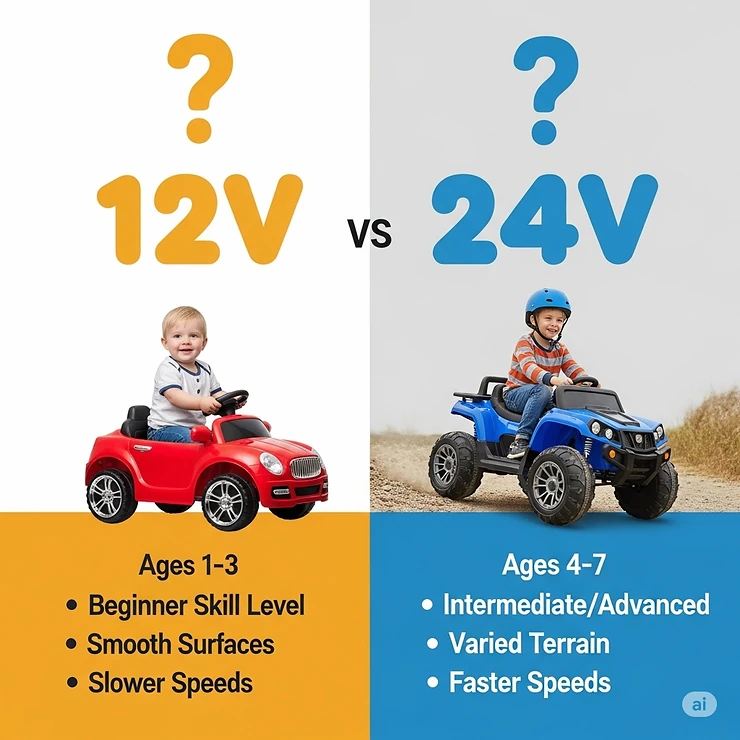
🔮 Future Trends and Market Evolution
The ride-on toy industry continues evolving rapidly, with emerging technologies and changing consumer preferences shaping the future of 12v vs 24v ride on toys.
Battery Technology Advancements
Lithium-ion batteries are beginning to replace traditional lead-acid systems in premium models. These advanced batteries offer:
⚡ 50-70% weight reduction compared to lead-acid
⚡ Faster charging times (2-4 hours vs 8-12 hours)
⚡ Extended lifespan (5-7 years vs 2-3 years)
⚡ Improved cold-weather performance
⚡ More consistent power delivery throughout discharge cycles
However, lithium systems currently add $200-400 to vehicle costs, limiting adoption to premium market segments.
Smart Technology Integration
Connected features are becoming standard in higher-end models:
📱 Smartphone app integration for performance monitoring
📱 GPS tracking for safety and theft prevention
📱 Remote diagnostics and maintenance alerts
📱 Performance tuning and speed limiting controls
📱 Usage analytics and safety reporting
The Razor brand has pioneered some of these features in their latest models, setting trends that other manufacturers are following.
Safety Innovation Trends
Advanced safety systems are emerging across both voltage categories:
🛡️ Automatic collision avoidance using proximity sensors
🛡️ Electronic stability control for enhanced handling
🛡️ Improved remote override systems with instant response
🛡️ Biometric safety locks requiring parental authentication
🛡️ Emergency stop systems activated by vocal commands
These innovations address parental safety concerns while maintaining the excitement that children demand.
Environmental Sustainability Focus
Manufacturers increasingly emphasize environmental responsibility:
♻️ Recyclable battery programs for end-of-life disposal
♻️ Biodegradable plastic components in non-critical applications
♻️ Solar charging options for extended outdoor use
♻️ Modular designs enabling repair rather than replacement
♻️ Carbon-neutral manufacturing processes
Market Segmentation Evolution
The traditional 12V/24V division is expanding into more nuanced categories:
Entry Level (6-12V): Focus on safety and simplicity for youngest users
Standard (12-18V): Balanced performance for mainstream applications
Performance (24-36V): Enhanced capability for serious young riders
Premium (48V+): Adult-supervised high-performance systems
This segmentation allows more precise matching of vehicle capabilities to user requirements.
Customization and Personalization Trends
Modern families increasingly demand customizable options:
🎨 Interchangeable body panels and styling elements
🎨 Programmable performance profiles for different users
🎨 Modular accessory systems for functional expansion
🎨 Custom graphics and personalization options
🎨 Adaptive controls accommodating special needs
Autonomous and Semi-Autonomous Features
Emerging autonomous technologies are beginning to appear:
🤖 Follow-me modes using smartphone tracking
🤖 Preset route programming for safe independent exploration
🤖 Automatic return-to-base functionality
🤖 Geofencing with automatic speed reduction in designated areas
🤖 Collision avoidance with automatic braking systems
Market Growth Projections
Industry analysts project continued growth in the ride-on toy sector:
12V Segment: Steady 3-5% annual growth driven by safety consciousness and affordability
24V Segment: Aggressive 8-12% annual growth fueled by performance demands and technological advancement
Premium Segment: Explosive 15-20% growth in high-end, feature-rich models
Global Market Influences
International trends affecting all voltage categories:
🌍 European safety regulations driving enhanced protection systems
🌍 Asian manufacturing innovations reducing production costs
🌍 North American performance preferences influencing global designs
🌍 Emerging market demand creating new budget categories
Technology Convergence Predictions
Expert predictions for next-generation development:
2025-2027 Timeline:
- Widespread lithium battery adoption
- Standard smartphone integration
- Enhanced safety systems
- Improved weather resistance
2027-2030 Timeline:
- Semi-autonomous navigation features
- Advanced AI safety systems
- Virtual reality integration
- Subscription-based feature updates
2030+ Timeline:
- Fully autonomous supervised operation
- Adaptive learning systems
- Augmented reality integration
- Sustainable manufacturing standards
These trends suggest that the fundamental 12v vs 24v ride on toys comparison will evolve into more complex decision matrices involving technology features, connectivity options, and automated safety systems.
💡 Investment and Purchase Decision Framework
Making the optimal choice between 12v vs 24v ride on toys requires a systematic evaluation framework that considers multiple factors beyond simple performance specifications.
Decision Matrix Development
Create a weighted scoring system based on your family’s priorities:
Safety (Weight: 30%)
- Child’s maturity level and risk assessment
- Available supervision and oversight capability
- Property characteristics and hazard potential
- Local safety regulations and requirements
Value (Weight: 25%)
- Initial purchase price vs budget constraints
- Expected lifespan and usage frequency
- Maintenance and operating cost projections
- Resale value potential
Performance (Weight: 20%)
- Speed and power requirements for intended use
- Terrain capability matching property characteristics
- Age range coverage for growing children
- Feature requirements and nice-to-have options
Practical Considerations (Weight: 15%)
- Storage space and accessibility requirements
- Assembly complexity and tool requirements
- Availability of local service and parts support
- Warranty coverage and customer service quality
Future Planning (Weight: 10%)
- Child’s developmental trajectory and interests
- Family expansion plans and sibling considerations
- Property changes or relocation possibilities
- Technology upgrade desires and compatibility
Financial Planning Strategies
Budget-Conscious Approach: Start with quality 12V models from reputable manufacturers like Best Choice Products. These provide excellent value and allow assessment of your child’s interest level before considering 24V upgrades.
Performance-Focused Approach: Invest directly in premium 24V models like the Razor MX350 if your child demonstrates readiness and your usage scenarios demand enhanced capability.
Family-Optimized Approach: Consider purchasing both categories to serve different children or different use cases. Many families find this strategy provides optimal coverage across age ranges and situations.
Risk Assessment Framework
Low-Risk Scenarios (Favor 12V):
- First-time ride-on vehicle owners
- Younger children (3-5 years)
- Small, controlled environments
- Urban/suburban properties
- High parental supervision availability
Moderate-Risk Scenarios (Either Option):
- Experienced young riders
- Children aged 6-8 years
- Mixed terrain availability
- Moderate-sized properties
- Occasional supervision scenarios
Higher-Risk Scenarios (24V with Precautions):
- Older children seeking performance
- Large properties with varied terrain
- Children with demonstrated responsibility
- Families prioritizing long-term value
- Situations requiring maximum capability
Implementation Timeline Strategy
Phase 1: Research and Evaluation (2-4 weeks)
- Define requirements and constraints
- Research specific models and reviews
- Establish budget parameters
- Evaluate local availability and support
Phase 2: Decision and Purchase (1-2 weeks)
- Apply decision framework scoring
- Compare finalist options
- Negotiate pricing and warranty terms
- Arrange delivery and assembly support
Phase 3: Preparation and Setup (1 week)
- Prepare assembly workspace and tools
- Review safety equipment requirements
- Plan initial usage scenarios and rules
- Establish maintenance schedule and procedures
Phase 4: Introduction and Training (2-4 weeks)
- Conduct initial safety orientation
- Supervise early usage sessions
- Adjust settings and controls as needed
- Establish ongoing usage rules and boundaries
Phase 5: Optimization and Maintenance (Ongoing)
- Monitor performance and satisfaction levels
- Adjust maintenance schedules based on usage
- Plan upgrades or modifications as appropriate
- Evaluate success metrics and lessons learned
Success Metrics and Evaluation
Quantitative Measures:
- Hours of usage per week/month
- Maintenance cost per hour of operation
- Safety incidents or concerns
- Battery performance and longevity
- Resale value retention
Qualitative Measures:
- Child satisfaction and engagement levels
- Skill development and confidence building
- Family bonding and shared experiences
- Overall purchase satisfaction scores
- Recommendation likelihood to other families
Long-Term Strategy Development
Growth Planning: Consider how your choice supports your child’s developmental trajectory. 12V models provide excellent foundations for eventual 24V progression, while 24V models offer extended utility as children grow.
Family Integration: Evaluate how ride-on vehicles fit within your family’s overall recreational and developmental activities. The most successful purchases complement rather than compete with other interests.
Technology Evolution: Plan for technological advancement and feature evolution. Choose models from manufacturers with strong track records of ongoing support and upgrade options.
This comprehensive framework ensures that your 12v vs 24v ride on toys decision aligns with your family’s specific needs, constraints, and long-term objectives.
🎯 Ready to Make the Right Choice?
→Your child’s perfect ride-on adventure awaits! These carefully researched models represent the best value in their respective categories. Click on any highlighted product to check current Amazon pricing and read real customer reviews. Don’t wait – give your child the gift of outdoor excitement and confidence-building adventures! 🚗⚡
❓ Frequently Asked Questions
❓ How long do 12v vs 24v ride on toys typically last with regular use?
❓ Can I upgrade a 12V ride on toy to 24V power?
❓ What's the real difference in operating costs between 12v and 24v ride on toys?
❓ Are 24V ride on toys safe for 6-year-old children?
❓ How do weather conditions affect 12v vs 24v ride on toys performance?
Recommended for You
- 7 Best 6v vs 12v battery ride on toys for Ultimate Fun in 2025
- 7 Best 12V Battery for Ride On Toys – Ultimate Power Guide 2025
- 7 Ultimate King Size Race Car Bed Options That Will Transform Your Bedroom in 2025
Disclaimer: This article contains affiliate links. If you purchase products through these links, we may earn a small commission at no additional cost to you.
✨ Found this helpful? Share it with your friends! 💬🤗

